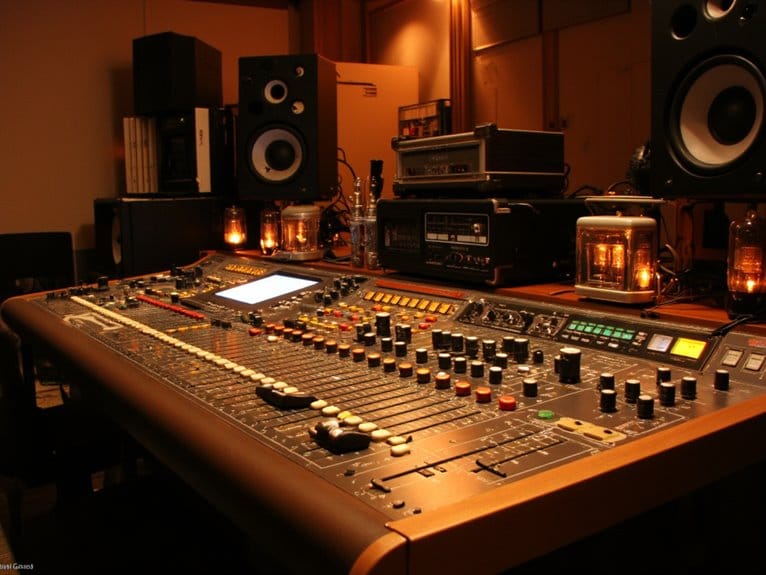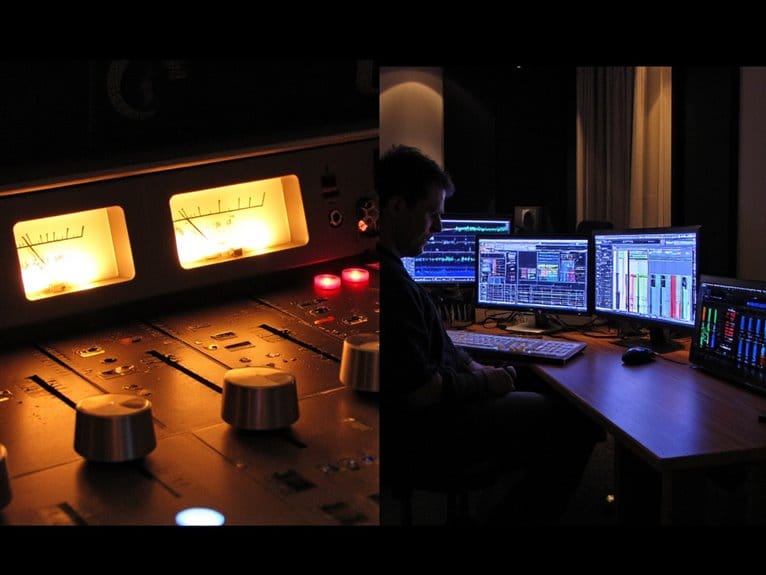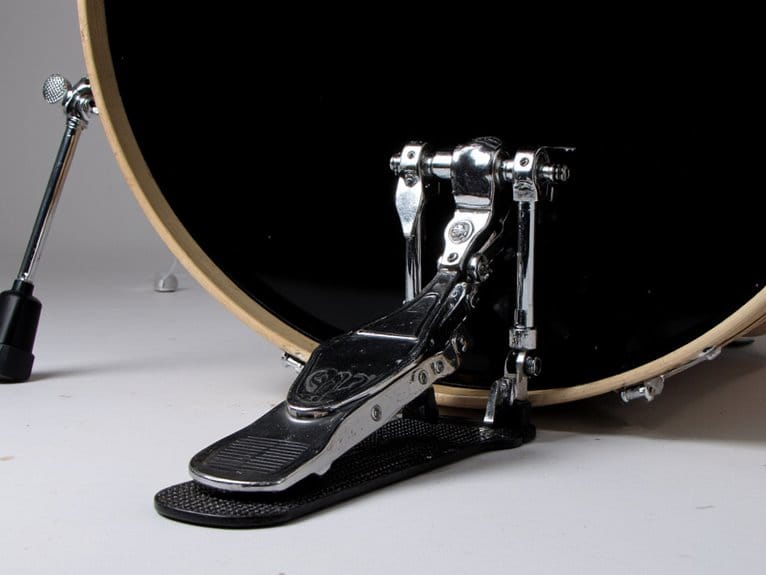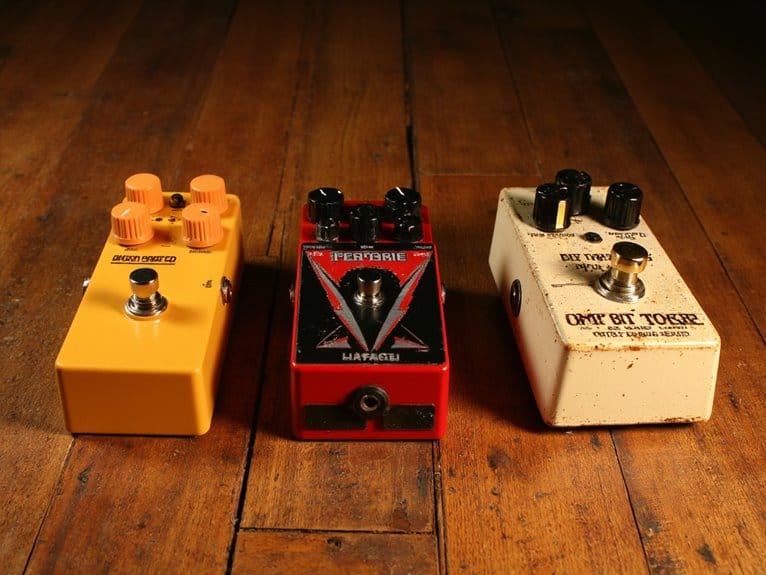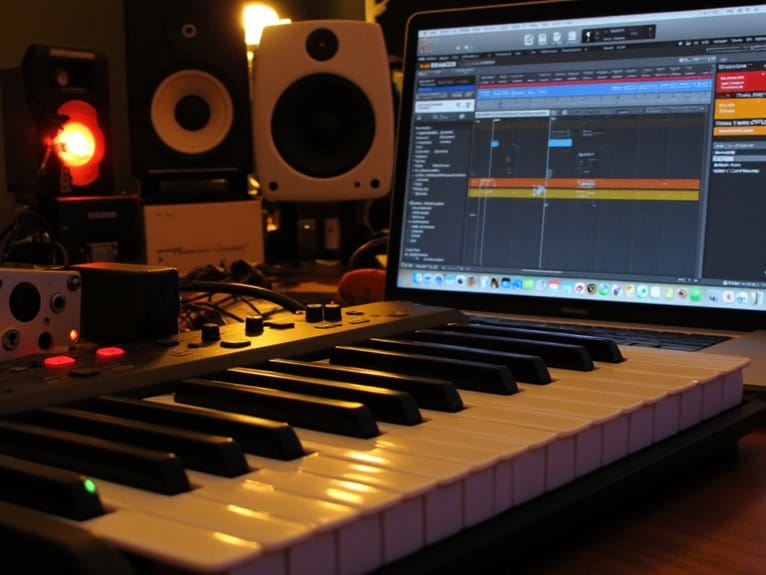Mix Translation: Making Your Mix Work Everywhere
Mix translation guarantees your carefully crafted studio sound maintains its impact across earbuds, car stereos, and smartphone speakers through strategic frequency balancing, dynamics control, and phase compatibility testing. You’ll need to check your mix on multiple playback systems, calibrate your monitoring environment around -20 dB RMS, and address room acoustics with bass traps and absorption panels at reflection points. The techniques below will transform your studio-perfect mixes into universally powerful recordings.
We are supported by our audience. When you purchase through links on our site, we may earn an affiliate commission, at no extra cost for you. Learn more.
Notable Insights
- Test your mix on multiple playback systems including car stereos, earbuds, and smartphone speakers to identify balance issues.
- Maintain proper frequency balance across the audio spectrum to ensure clarity on both large and small speakers.
- Check mono compatibility to prevent phase cancellation issues that can cause elements to disappear on single-speaker devices.
- Use A/B comparisons with reference tracks to keep mixing decisions grounded and ensure professional translation standards.
- Calibrate your listening environment with proper monitor placement and acoustic treatment to make accurate mixing decisions.
Understanding the Fundamentals of Mix Translation
Translation-the holy grail of mixing that separates amateur bedroom producers from professionals who’ve learned the hard way that a mix sounding incredible on $3,000 studio monitors means absolutely nothing if it falls apart on earbuds, car speakers, or your grandmother’s ancient radio.
You’re fundamentally creating one version of your song that must work across dozens of different playback scenarios, each with unique frequency responses, dynamic limitations, and stereo capabilities.
The fundamentals boil down to four critical pillars: frequency balance that maintains clarity across the spectrum, dynamics control that preserves punch without overwhelming smaller speakers, phase compatibility ensuring mono devices don’t butcher your carefully crafted elements, and critical listening practices that catch problems before they reach your audience’s ears.
Testing Your Mix Across Multiple Playback Systems
Understanding these fundamentals means nothing if you don’t systematically test how your mix performs in the real world, where your audience actually lives and listens.
I’ve learned that playback variations across different systems reveal translation problems you’ll never catch in your studio alone. Testing on car stereos, Bluetooth speakers, and smartphones exposes how speaker characteristics dramatically affect your mix’s balance and clarity.
Your studio monitors lie to you-real-world playback systems reveal the harsh truth about your mix’s weaknesses.
Cross-checking between headphones and monitors helps identify elements that won’t translate well, while listening on unfamiliar systems provides that realistic perspective we desperately need.
Don’t forget mono compatibility checking-it’ll expose phase issues that could destroy your mix on single-speaker setups, and frequent A/B comparisons with reference tracks keep you grounded. Professional mixers with built-in phantom power and DSP effects enable versatile monitoring setups for comprehensive translation testing.
Professional nearfield monitors with flat frequency response provide the most accurate foundation for these critical translation tests, ensuring you hear exactly what’s in your mix without coloration.
Essential Tools and Plugins for Translation Success
While testing your mix across different systems reveals problems, the right translation tools can help you identify and fix those issues before they become deal-breakers in your final product.
Modern translation tools like Murf AI and Adobe Firefly offer sophisticated audio processing capabilities that maintain speaker characteristics while converting content across multiple formats, which proves invaluable when you’re preparing mixes for international distribution.
These platforms provide workflow optimization through automated processes that reduce manual intervention by up to 80%, allowing you to focus on creative decisions rather than technical conversions.
Integration plugins such as Smartling and Lingotek streamline your production pipeline by connecting directly to professional services, while tools like WPS AI offer API embedding for customized solutions that fit seamlessly into your existing audio workflow.
Monitoring Strategies and Equipment Selection
Since your mix’s success ultimately depends on what you’re hearing during the mixing process, I’ve learned that choosing the right monitoring setup can make or break your translation across different playback systems.
Proper monitor placement, aimed directly at your ears with minimal obstructions, guarantees accurate stereo imaging and frequency perception that’ll help your mixes translate consistently.
I’ll calibrate my listening volume around -20 dB RMS, using pink noise and SPL meters for consistency, while frequently checking at different volumes to assess vocal presence and bass clarity.
For live situations, feedback control becomes essential-I identify problematic frequencies by gradually raising mic levels, then apply surgical EQ cuts under 3 dB to maintain natural tone while preventing ringing.
Room Treatment and Calibration for Accurate Results
Even the best monitors and most careful calibration won’t deliver accurate results if your room’s acoustics are working against you, which is why I’ve found that strategic acoustic treatment forms the foundation of any serious mixing environment. Your room dimensions directly influence where standing waves occur, and proper acoustic materials placement addresses these issues without requiring expensive renovations.
| Treatment Type | Primary Location | Key Benefit |
|---|---|---|
| Bass Traps | Vertical corners | Controls low-frequency buildup |
| Absorption Panels | First reflection points | Reduces comb filtering |
| Diffusers | Back wall | Maintains room liveliness |
You don’t need full coverage-targeted treatment at critical points delivers meaningful improvements. Focus on corner bass traps first, then address side wall reflections using the mirror technique to identify placement points, ensuring your mixes translate accurately across different playback systems.
On a final note
You’ve now got the roadmap to achieve professional translation across any playback system. Remember, there’s no magic bullet-consistent testing, proper monitoring, and room treatment form your foundation. I’ve watched countless engineers skip these fundamentals, only to discover their mixes fall apart on real-world systems. Start with your monitoring chain, test religiously across multiple sources, and don’t trust your mix until it translates everywhere that matters.

